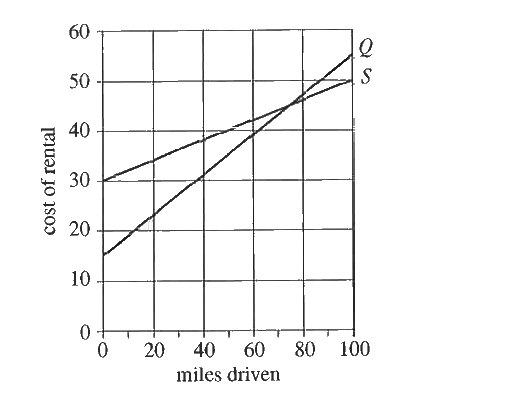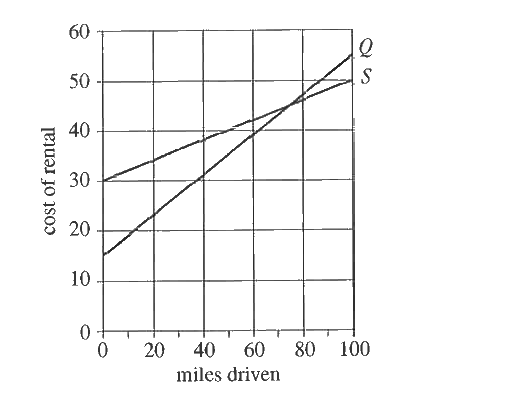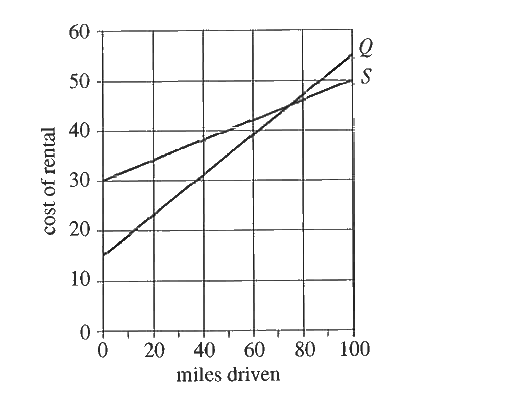A part of monthly hostel charges is fixed and the remaining depends on the number of days one has taken food in the mess. When a student A takes food for 20 days she has to pay 1000 as hostel charges whereas a student who takes B food for 26 days, pays 1180 as hostel charges. Find the fixed charges and the cost of food per day.
The correct Answer is:Fixed charge = Rs. 400, Cost of food per day = Rs. 30
Step by step video solution for A part of monthly hostel charges is fixed and the remaining depends on the number of days one has taken food in the mess. When a student A takes food for 20 days she has to pay 1000 as hostel charges whereas a student who takes B food for 26 days, pays 1180 as hostel charges. Find the fixed charges and the cost of food per day. by Maths experts to help you in doubts & scoring excellent marks in Class 10 exams.
Updated on:21/07/2023Topper's Solved these Questions
- LINEAR EQUATIONS IN TWO VARIABLES BOOK - NAGEEN PRAKASHAN ENGLISHCHAPTER - LINEAR EQUATIONS IN TWO VARIABLES EXERCISE - Revision Exercise Very Short Answer Questions
9 Videos
- LINEAR EQUATIONS IN TWO VARIABLES BOOK - NAGEEN PRAKASHAN ENGLISHCHAPTER - LINEAR EQUATIONS IN TWO VARIABLES EXERCISE - Revision Exercise Short Answer Questions
10 Videos
- LINEAR EQUATIONS IN TWO VARIABLES BOOK - NAGEEN PRAKASHAN ENGLISHCHAPTER - LINEAR EQUATIONS IN TWO VARIABLES EXERCISE - Exercise 3d
35 Videos
- INTRODUCTION TO TRIGONOMETRYBOOK - NAGEEN PRAKASHAN ENGLISHCHAPTER - INTRODUCTION TO TRIGONOMETRYEXERCISE - Revision Exercise Long Answer Questions
5 Videos
- POLYNOMIALSBOOK - NAGEEN PRAKASHAN ENGLISHCHAPTER - POLYNOMIALSEXERCISE - Revision Exercise Long Answer Questions
4 Videos
Similar Questions
A part of monthly hostel charges is fixed and the remaining depends on the number of days one has taken food in the mess. When a student A takes food for 25 days he has to pay 4500 as hostel charges whereas a student who takes B food for 30 days, pays 5200 as hostel charges. Find the fixed charges per month and the cost of food per day.
View SolutionA lending library has a fixed charge for the first three days and an additional charge for each day thereafter. Saritha paid Rs 27 for a book kept for seven days, while Susy paid Rs 21 for the book she kept for five days. Find the fixed charge and the charge for each extra day.
View Solution
Knowledge Check
At both Quick Car Rental and Speedy Car Rental, the cost, in dollars, of renting a full - size car depends on a fixed daily rental fee and a fixed charge per mile that the car is driven. However, the daily rental fee and the charge per mile are not the same for the 2 companies. In the graph below, line Q represents the total cost for Quick Car Rental and line S represents the total cost for Speedy Car Rental.

Robert plans to rent a full-size car for 1 day and drive only 50 miles. If his only consideration is to incur the least cost, which company should he choose?AQuick Car Rental, because the cost is $5.00 less.BQuick Car Rental, because the cost is $15.00 less.CEither company, because the costs are equal.DSpeedy Car Rental, becuase the cost is $5.00 less.At both Quick Car Rental and Speedy Car Rental, the cost, in dollars, of renting a full - size car depends on a fixed daily rental fee and a fixed charge per mile that the car is driven. However, the daily rental fee and the charge per mile are not the same for the 2 companies. In the graph below, line Q represents the total cost for Quick Car Rental and line S represents the total cost for Speedy Car Rental.

If you rent a full-size car from Quick Car Rental for 1 day, how much more would the total rental cost be if you drove the car 78 miles than if you drove it 77 miles?A$0.10B$0.15C$0.20D$0.40At both Quick Car Rental and Speedy Car Rental, the cost, in dollars, of renting a full - size car depends on a fixed daily rental fee and a fixed charge per mile that the car is driven. However, the daily rental fee and the charge per mile are not the same for the 2 companies. In the graph below, line Q represents the total cost for Quick Car Rental and line S represents the total cost for Speedy Car Rental.

What would be the total cost of renting a full-size car from Speedy Car Rental for 1 day and driving the car 150 miles?A$ 60B$ 75C$ 85D$ 90
A shopkeeper gives books on rent for reading. She takes a fixed charge for the first two days and an additional charge for each day thereafter. Latika paid Rs. 22 for a book kept for six days, while Anand paid Rs. 16 for the book kept for four days. Find the fixed charges and the charge for each extra day.
View SolutionIn a hostel mess, 50kg rice are consumed every day. If each student gets 400gm of rice per day, find the number of students who take meals in the hostel mess.
View SolutionWe've all heard the adage: practice makes perfect! In other words, acquiring skills takes time and effort. But how exactly does one go about learning a complex subject such as tennis, calculus, or how to play the violin? An age-old answer is: practice one skill at a time. A beginning pianist might rehearse scales before chords. A tennis player practices the forehand before the backhand. Learning researchers call this "blocking," and because it is commonsensical and easy to schedule, blocking is dominant in schools and training programs.
However, another strategy promises improved results. Enter "interleaving," a largely unheard of technique that is capturing the attention of cognitive psychologists and neuroscientists. Whereas blocking involves practicing one skill at a time before the next (for example, "skill A" before "skill B" and so on, forming the pattern "AAABBBCCC"), in interleaving one mixes, or interleaves, practice on several related skills together (forming for example the pattern "ABCABCABC"). For instance, a pianist alternates practice between scales, chords, and arpeggios, while a tennis player alternates practice between forehands, backhands, and volleys. Given interleaving's promise, it is surprising then that few studies have investigated its utility in everyday applications. However, a new study by cognitive psychologist Doug Rohrer takes a step towards addressing that gap. Rohrer and his team are the first to implement interleaving in actual classrooms. The location: middle schools in Tampa, Florida. The target skills: algebra and geometry.
The three-month study involved teaching 7th graders slope and graph problems. Weekly lessons were largely unchanged from standard practice. Weekly homework worksheets, however, featured an interleaved or blocked design. When interleaved, both old and new problems of different types were mixed together. Of the nine participating classes, five used interleaving for slope problems and blocking for graph problems, the reverse occurred in the remaining four. Five days after the last lesson, each class held a Teview session for all students. A surprise final test occurred one day or one month later. The result? When the test was one day later, scores were 25 percent better for problems trained with interleaving, at one month later, the interleaving advantage grew to 76 percent.
These results are important for a host of reasons. First, they show that interleaving works in real-world, extended use. It is highly effective with an almost ubiquitous subject, math. The interleaving effect is long-term and the advantage over blocking actually increases with the passage of time. The benefit even persists when blocked materials receive additional review. Overall, the interleaving effect can be strong, stable, and long lasting Researchers are now working to understand why interleaving yields such impressive results. One prominent explanation is that it improves the brain's ability to tell apart concepts. With blocking, once you know what solution to use, the hard part is over. With interleaving, each practice attempt is different from the last, so rote responses don't work. Instead, your brain must continuously focus on searching for different solutions. That process can improve your ability to learn critical features of skills.
A second explanation is that interleaving strengthens memory associations. With blocking, a single strategy, temporarily held in short-term memory, is sufficient. That's not the case with interleaving-the correct solution changes from one practice attempt to the next. As a result, your brain is continually engaged at retrieving different responses and bringing them into short term memory. Both of these accounts imply that increased effort during training is needed when interleaving is used. This corresponds to a potential drawback of the technique, namely that the learning process often feels more gradual and difficult at the outset. However, that added effort can generate better, longer lasting results.
For each word given below choose the correct meaning (as used in the passage) from the options provided:
yields
View SolutionWe've all heard the adage: practice makes perfect! In other words, acquiring skills takes time and effort. But how exactly does one go about learning a complex subject such as tennis, calculus, or how to play the violin? An age-old answer is: practice one skill at a time. A beginning pianist might rehearse scales before chords. A tennis player practices the forehand before the backhand. Learning researchers call this "blocking," and because it is commonsensical and easy to schedule, blocking is dominant in schools and training programs.
However, another strategy promises improved results. Enter "interleaving," a largely unheard of technique that is capturing the attention of cognitive psychologists and neuroscientists. Whereas blocking involves practicing one skill at a time before the next (for example, "skill A" before "skill B" and so on, forming the pattern "AAABBBCCC"), in interleaving one mixes, or interleaves, practice on several related skills together (forming for example the pattern "ABCABCABC"). For instance, a pianist alternates practice between scales, chords, and arpeggios, while a tennis player alternates practice between forehands, backhands, and volleys. Given interleaving's promise, it is surprising then that few studies have investigated its utility in everyday applications. However, a new study by cognitive psychologist Doug Rohrer takes a step towards addressing that gap. Rohrer and his team are the first to implement interleaving in actual classrooms. The location: middle schools in Tampa, Florida. The target skills: algebra and geometry.
The three-month study involved teaching 7th graders slope and graph problems. Weekly lessons were largely unchanged from standard practice. Weekly homework worksheets, however, featured an interleaved or blocked design. When interleaved, both old and new problems of different types were mixed together. Of the nine participating classes, five used interleaving for slope problems and blocking for graph problems, the reverse occurred in the remaining four. Five days after the last lesson, each class held a Teview session for all students. A surprise final test occurred one day or one month later. The result? When the test was one day later, scores were 25 percent better for problems trained with interleaving, at one month later, the interleaving advantage grew to 76 percent.
These results are important for a host of reasons. First, they show that interleaving works in real-world, extended use. It is highly effective with an almost ubiquitous subject, math. The interleaving effect is long-term and the advantage over blocking actually increases with the passage of time. The benefit even persists when blocked materials receive additional review. Overall, the interleaving effect can be strong, stable, and long lasting Researchers are now working to understand why interleaving yields such impressive results. One prominent explanation is that it improves the brain's ability to tell apart concepts. With blocking, once you know what solution to use, the hard part is over. With interleaving, each practice attempt is different from the last, so rote responses don't work. Instead, your brain must continuously focus on searching for different solutions. That process can improve your ability to learn critical features of skills.
A second explanation is that interleaving strengthens memory associations. With blocking, a single strategy, temporarily held in short-term memory, is sufficient. That's not the case with interleaving-the correct solution changes from one practice attempt to the next. As a result, your brain is continually engaged at retrieving different responses and bringing them into short term memory. Both of these accounts imply that increased effort during training is needed when interleaving is used. This corresponds to a potential drawback of the technique, namely that the learning process often feels more gradual and difficult at the outset. However, that added effort can generate better, longer lasting results.
For each word given below choose the correct meaning (as used in the passage) from the options provided:
Retrieving
View SolutionWe've all heard the adage: practice makes perfect! In other words, acquiring skills takes time and effort. But how exactly does one go about learning a complex subject such as tennis, calculus, or how to play the violin? An age-old answer is: practice one skill at a time. A beginning pianist might rehearse scales before chords. A tennis player practices the forehand before the backhand. Learning researchers call this "blocking," and because it is commonsensical and easy to schedule, blocking is dominant in schools and training programs.
However, another strategy promises improved results. Enter "interleaving," a largely unheard of technique that is capturing the attention of cognitive psychologists and neuroscientists. Whereas blocking involves practicing one skill at a time before the next (for example, "skill A" before "skill B" and so on, forming the pattern "AAABBBCCC"), in interleaving one mixes, or interleaves, practice on several related skills together (forming for example the pattern "ABCABCABC"). For instance, a pianist alternates practice between scales, chords, and arpeggios, while a tennis player alternates practice between forehands, backhands, and volleys. Given interleaving's promise, it is surprising then that few studies have investigated its utility in everyday applications. However, a new study by cognitive psychologist Doug Rohrer takes a step towards addressing that gap. Rohrer and his team are the first to implement interleaving in actual classrooms. The location: middle schools in Tampa, Florida. The target skills: algebra and geometry.
The three-month study involved teaching 7th graders slope and graph problems. Weekly lessons were largely unchanged from standard practice. Weekly homework worksheets, however, featured an interleaved or blocked design. When interleaved, both old and new problems of different types were mixed together. Of the nine participating classes, five used interleaving for slope problems and blocking for graph problems, the reverse occurred in the remaining four. Five days after the last lesson, each class held a Teview session for all students. A surprise final test occurred one day or one month later. The result? When the test was one day later, scores were 25 percent better for problems trained with interleaving, at one month later, the interleaving advantage grew to 76 percent.
These results are important for a host of reasons. First, they show that interleaving works in real-world, extended use. It is highly effective with an almost ubiquitous subject, math. The interleaving effect is long-term and the advantage over blocking actually increases with the passage of time. The benefit even persists when blocked materials receive additional review. Overall, the interleaving effect can be strong, stable, and long lasting Researchers are now working to understand why interleaving yields such impressive results. One prominent explanation is that it improves the brain's ability to tell apart concepts. With blocking, once you know what solution to use, the hard part is over. With interleaving, each practice attempt is different from the last, so rote responses don't work. Instead, your brain must continuously focus on searching for different solutions. That process can improve your ability to learn critical features of skills.
A second explanation is that interleaving strengthens memory associations. With blocking, a single strategy, temporarily held in short-term memory, is sufficient. That's not the case with interleaving-the correct solution changes from one practice attempt to the next. As a result, your brain is continually engaged at retrieving different responses and bringing them into short term memory. Both of these accounts imply that increased effort during training is needed when interleaving is used. This corresponds to a potential drawback of the technique, namely that the learning process often feels more gradual and difficult at the outset. However, that added effort can generate better, longer lasting results.
The main effect of the words "adage" and "age old" is to:
View Solution